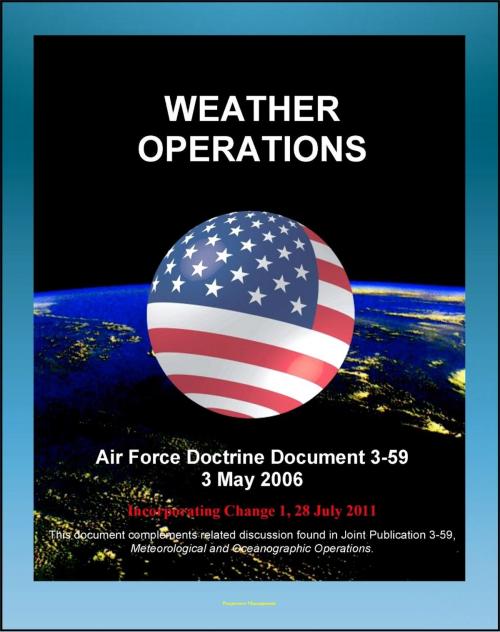Air Force Doctrine Document 3-59: Weather Operations - Principles, Air Force Combat Climatology Center (AFCCC), Space Weather Branch, History of Desert Storm and Operation Eagle Claw
Nonfiction, Science & Nature, Science, Other Sciences, Meteorology, History, Military, Aviation| Author: | Progressive Management | ISBN: | 9781476324623 |
| Publisher: | Progressive Management | Publication: | April 19, 2012 |
| Imprint: | Smashwords Edition | Language: | English |
| Author: | Progressive Management |
| ISBN: | 9781476324623 |
| Publisher: | Progressive Management |
| Publication: | April 19, 2012 |
| Imprint: | Smashwords Edition |
| Language: | English |
This Air Force doctrine document (AFDD) establishes doctrinal guidance for organizing weather forces and employing weather operations capabilities in support of air, space, and surface forces at the operational level of conflict. It is a critical element of Air Force operational-level doctrine and as such should form the basis from which Air Force and Army commanders integrate weather capabilities into their operations. Air Force tactics, techniques, and procedures should complement this doctrine at the tactical level.
The Department of Defense operates in a challenging natural environment stretching from the surface of the earth into the far reaches of space. While the environment has beleaguered military operations for centuries, it has also provided strategic, operational, and tactical advantage to the forewarned. Sun Tzu once proclaimed, "Know the ground, know the weather; your victory will be total." Indeed, history has shown that commanders who have exploited knowledge of the environment and its effects have been rewarded with victory, while those who have ignored the environment have often met with failure.
Air Force weather operations are now more sophisticated, accurate, and precise than ever, presenting air, space, and surface forces with an even greater opportunity to exploit knowledge of the natural environment as a force multiplier. This can only be accomplished, however, when commanders integrate environmental information and its effects on operations into all aspects of planning, execution, assessment and sustainment. It is an essential element on the road to victory.
Contents: Chapter One - Overview Of Weather Operations * Chapter Two - The Weather Operations Process * Chapter Three - Organizing, Commanding, And Employing Weather Forces * Chapter Four - Training And Education
This Air Force doctrine document (AFDD) establishes doctrinal guidance for organizing weather forces and employing weather operations capabilities in support of air, space, and surface forces at the operational level of conflict. It is a critical element of Air Force operational-level doctrine and as such should form the basis from which Air Force and Army commanders integrate weather capabilities into their operations. Air Force tactics, techniques, and procedures should complement this doctrine at the tactical level.
The Department of Defense operates in a challenging natural environment stretching from the surface of the earth into the far reaches of space. While the environment has beleaguered military operations for centuries, it has also provided strategic, operational, and tactical advantage to the forewarned. Sun Tzu once proclaimed, "Know the ground, know the weather; your victory will be total." Indeed, history has shown that commanders who have exploited knowledge of the environment and its effects have been rewarded with victory, while those who have ignored the environment have often met with failure.
Air Force weather operations are now more sophisticated, accurate, and precise than ever, presenting air, space, and surface forces with an even greater opportunity to exploit knowledge of the natural environment as a force multiplier. This can only be accomplished, however, when commanders integrate environmental information and its effects on operations into all aspects of planning, execution, assessment and sustainment. It is an essential element on the road to victory.
Contents: Chapter One - Overview Of Weather Operations * Chapter Two - The Weather Operations Process * Chapter Three - Organizing, Commanding, And Employing Weather Forces * Chapter Four - Training And Education















